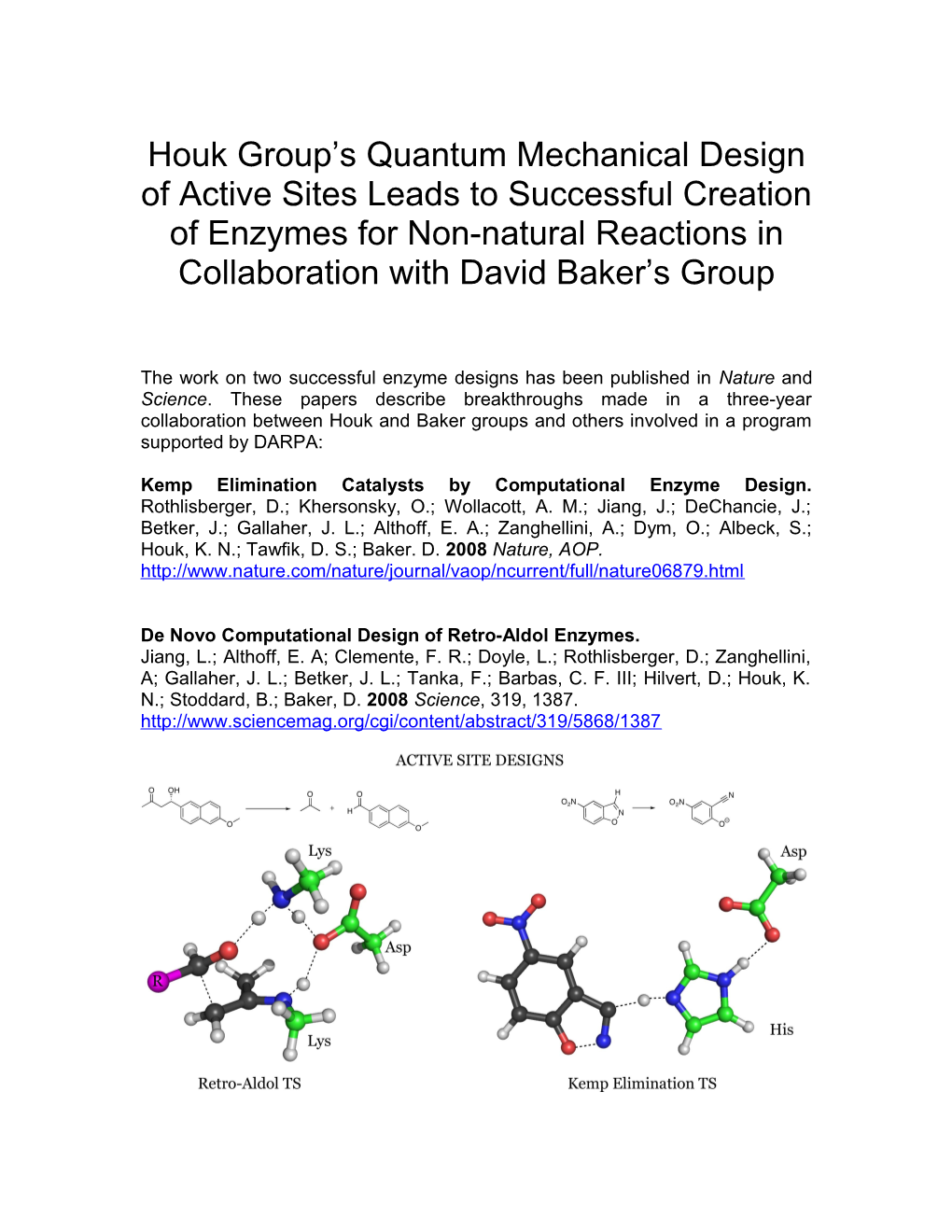Houk Group’s Quantum Mechanical Design of Active Sites Leads to Successful Creation of Enzymes for Non-natural Reactions in Collaboration with David Baker’s Group
The work on two successful enzyme designs has been published in Nature and Science. These papers describe breakthroughs made in a three-year collaboration between Houk and Baker groups and others involved in a program supported by DARPA:
Kemp Elimination Catalysts by Computational Enzyme Design. Rothlisberger, D.; Khersonsky, O.; Wollacott, A. M.; Jiang, J.; DeChancie, J.; Betker, J.; Gallaher, J. L.; Althoff, E. A.; Zanghellini, A.; Dym, O.; Albeck, S.; Houk, K. N.; Tawfik, D. S.; Baker. D. 2008Nature, AOP.
De Novo Computational Design of Retro-Aldol Enzymes.
Jiang, L.; Althoff, E. A; Clemente, F. R.; Doyle, L.; Rothlisberger, D.; Zanghellini, A; Gallaher, J. L.; Betker, J. L.; Tanka, F.; Barbas, C. F. III; Hilvert, D.; Houk, K. N.; Stoddard, B.; Baker, D. 2008Science, 319, 1387.
For UCLA’s press release on these papers, see:
INSIDE-OUT DESIGN OF NEW ENZYME CATALYSTS
The success of inverse protein folding reached a milestone with the design and successful experimental proof of structure of a 93-residue / protein called Top7.1 The next great challenge of protein design is to predict and create a functional protein for a reaction for which no natural enzymes are known.
The first successful response to this challenge was achieved in a collaborative effort between our group and that of David Baker (University of Washington) protocol for enzyme design. The inside-out approach we developed starts with the design of an active site with the appropriate functionality for catalysis using quantum mechanical calculations. We call this a theozyme, for theoretical enzyme. The advantage of this computational method is the ability to tune optimal functionality that a protein can use to bind and stabilize the transition state.
Baker’s group then designs a protein that is predicted to fold with the calculated active site structure. Design efforts involve splicing the active site into existing protein scaffolds, selected based on the ability of the fold to orient the functional groups necessary for proficient catalysis. Rosetta design energy functions and minimization methods are subsequently employed to redesign the vicinity of the active site with side-chains that will stabilize the protein and maintain the geometry of the catalytic site. Finally, the designed proteins are expressed in E. coli from the corresponding DNA, and activities are assayed.
Theozymes serve as a blueprint for the construction of active sites within a protein and are used for the prediction of activation barriers of catalyzed reactions in the theozyme relative to the uncatalyzed reaction in aqueous solution. Building an effective theozyme active depends on knowledge about the target reactions and how they can be catalyzed.
For the Kemp elimination, our group has previously shown that proper base (aspartate or glutamate) orientation and nonpolar environment are paramount to achieve rate acceleration.2 It was also determined that hydrogen-bonding to the developing oxyanion could potentially lead to rate acceleration.2
A covalent mechanism via enamine formation derived from a nucleophilic lysine side-chain was designed for the retro-aldolase reaction. This covalent mechanism was applied because it has been shown that, in general, proficiencies higher than 1011 M-1 can only be achieved through partially covalent catalysis, including covalent intermediate formation, general acid-base, and metal binding.3 Additional side-chains (Lys and Asp) were placed to act as a general acid/base. The catalytic importance of these residues are supported by calculations carried out by the Houk group4 and Wu et al.5 that point out the importance of stabilizing the negative charge of the developing alkoxide in the transition state in order to lower the energy barrier of the C-C bond forming step. This can be done either by proton transfer (acid catalysis)6-10 or by good coordination with multiple hydrogen bond donors.5
Active site designs for the Kemp elimination and the retro-aldol reaction are shown above.
Additional References:
1.Kuhlman, B.; Dantas, G.; Ireton, G. C.; Varani, G.; Stoddard, B. L.; Baker, D., Science 2003, 302, 1364-1368.
2.Na, J.; Houk, K. N.; Hilvert, D. J. Am. Chem. Soc. 1996, 118, 6462-6471.
3.Zhang, X.; Houk, K. N., Acc. Chem. Res. 2005, 38, 379-385.
4.Wu, Y.; Li, Y.; Na, J.; Houk, K. N., J. Org. Chem. 1993, 58, 4625-4628.
5.Tang, Z.; Luo-Ting, F. J.; Cui, X.; Gong, L. Z.; Mi, A. Q.; Jiang, Y. Z.; Wu, Y. D., J. Am. Chem. Soc. 2003, 125, 5262-5263.
6.Bahmanyar, S.; Houk, K. N., J. Am. Chem. Soc. 2001, 123, 11273-11283.
7.Bahmanyar, S.; Houk, K. N., J. Am. Chem. Soc. 2001, 123, 12911-12912.
8.Clemente, F. R.; Houk, K. N., Angew. Chem. Int. Ed. 2004, 43, 5766-5768.
9.Bahmanyar, S.; Houk, K. N.; Martin, H. J.; List, B., J. Am. Chem. Soc. 2003, 125, 2475-2479.
10.Hoang, L.; Bahmanyar, S.; Houk, K. N.; List, B., J. Am. Chem. Soc. 2003, 125, 16-17.
OUR WORK ON THE WEB
Medical News Today:
Yahoo News India:
ScienceDaily:
ScientistLive:
PhysOrg.com:
News-Medical-Net:
RxPG News:
Financial Express:
Science a GoGo:
DailyIndia.com:
NewKerala.com:
Medical, Health News:
The Hindu:
United Press International:
UC Newsroom:
ScienceCentric:
Biosingularity:
TamilStar:
MedIndia:
EuroGraduate:
Imperial Valley News:
Drug Discovery and Development:
